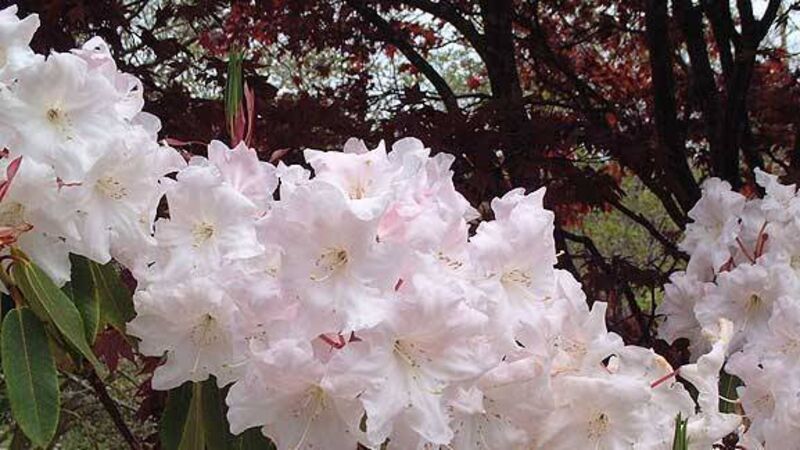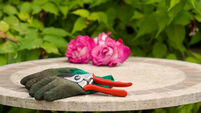Keep plants happy with nourished soil

PLANTS grow to produce seed and thus ensure the continuation of the species. That seed is often hidden inside fruits and sometimes beneath brightly coloured petals and flowers each of which is a natural work of art.
The flowers are produced to attract pollinators, different colours attracting different species and plants trying to outdo each other in their quest to lure the honey bee and ladybird to stop and collect their pollen. These pollinating insects will help create viable seed and thus future plants for the next growing season and in turn the nectar and foodstuff from these flowers and fruits will provide for the bees and friends, and so the wonderful world of nature continues.
Of course we make so much of flowers purely for their aesthetic beauty designing gardens around these beautiful flowers. Thousands of acres are used exclusively to grow plants simply to produce cut flowers for us to enjoy in a bouquets. It’s hard to better a simple vase full of flowers from the garden on the kitchen table.
We can help by making sure our garden plants are happy, healthy and well nourished. Mulching the beds during the winter with farmyard manure, spent mushroom compost, Celtic Gold or similar will benefit the garden no end and should be part of your regular gardening calendar.
All of these will have the effect of increasing the nutrient content of the soil. As they begin to break down they will also improve the texture and structure of the soil, adding to the layer of humus, and with improved structure comes a better ability to retain nutrients which may be added during the year.
Poor sandy soils have next to no ability to retain nutrients and hard, clay soils often lock the nutrients, making them inaccessible to the delicate plant roots leading to panning in the soil where you end up with an orange-coloured layer of iron underground.
So creating a crumbly rich layer of humus in this way improves the soil hugely. Obvious as it may sound, everything in the garden starts at the ground up.
Good soil leads to good root growth and development and thus good strong healthy plants. Equally poor soil will lead to the opposite. This is why it is so important to feed and nourish the soil more so than the plant.
It can be foolish in the extreme to spend your hard earned money on some stunning plants during a trip to the local garden centre and come home and plant them in unsuitable soil.
It can seem like a daunting challenge to figure out what plant needs what in terms of nutrients and growing conditions.
But don’t fret, for if a plant is unhappy with its lot it is unlikely to die before your eyes, more likely to simply not thrive and look sickly giving you ample time to remedy the situation. A couple of basic things to remember is that plants need nitrogen and magnesium for strong green leaves and in the case of Camellias, Rhododendrons and other ericaceous plants, iron will also be necessary.
If your Camellia leaves are looking hungry and pale green/yellow then it is most likely lacking in iron as due to the pH of the soil any iron underground is unavailable to the plant. Counteract this by providing it in a form that the plant can absorb, chelated or sequestered iron. Now is the time to start feeding the soil around these spring beauties with an acid plant food and continue feeding throughout the growing season.
Potassium is needed by plants to produce flowers and fruits and thus a plant food rich in this such as tomato food is a great liquid feed to get best results out of flowering plants, shrubs, bedding plants and of course not to forget, tomatoes.
Referring back to the Ericaceous plants, these will produce buds this autumn to open next spring and so to help promote more blooms feed this year as summer draws to an end during August and September with a good Tomato Food, Sulphate of Potash or other good quality feed that is high in Potassium. I have great results over the last few years with the Liquid Gold.
This is quite simply the liquid which comes off the vermicomposting process and which is extremely high in nutrients but also, thanks to the wonder of the earthworm, it also has probiotic qualities stimulating the beneficial microbes and micro organisms already in the soil. Furthermore, the wormcasts, and in particular the worm tea which is essentially what Liquid Gold is, has certain anti fungal properties.
Help nature to help you in the garden by paying attention to your soil and create a home plants will love to settle in and that the good guys of the soil will want to stay in, and in turn help your plants. It really is all one big circle.
April will soon be upon us and with the increasing temperatures and daylight hours growth is becoming more and more rapid. It’s the time of year in the garden that if you blink or miss a day everything seems to just take off, the garden indeed waits for no one.
Time enough then to make sure that your late summer flowering perennials are planted.
Dahlias, Gladiolas, Begonias, etc, all these can be grown easily from tubers and bulbs but would want to be getting in the ground over the next couple of weeks. No time to waste.









